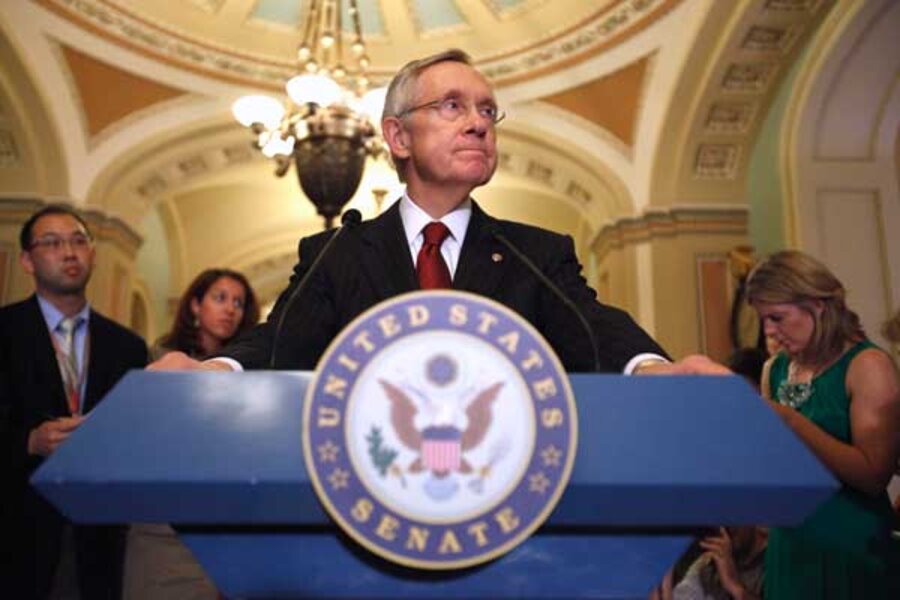How debt-ceiling deal would cut federal deficits by $2.1 trillion
Loading...
The spending cuts included in the bipartisan debt-ceiling deal would impose broad restraint on federal spending, but they are not going to put a sudden squeeze on programs like Social Security, nor will they of themselves solve America's deficit-spending problem.
Instead, look for a new era of austerity that starts with less-visible programs and ramps up slowly – with only minor federal spending cuts next year.
It's a careful bargain, designed to allow Republicans to say they took a major stride to curb runaway spending and Democrats to counter that they are avoiding cuts that hit hard on groups like the poor, seniors, and college students.
In total, the plan would reduce federal deficits by about $2.1 trillion between now and 2021 – a substantial amount of belt-tightening, although the country would continue to run deficits unless further changes were enacted. Many economists say about twice that amount of deficit reduction is needed to put the country on a sound fiscal footing.
The plan puts new caps on discretionary federal spending – spending not tied to entitlements like Medicare or Social Security. The resulting cuts reduce federal deficits by about $917 billion over the next 10 years, the Congressional Budget Office (CBO) estimated Monday. In conjunction with those cuts, the nation's debt limit could be raised by $900 billion, alleviating a looming crisis as the lack of authority to borrow makes it hard for the Treasury to pay government bills.
In order to hit that goal for spending cuts, numerous federal agencies would be affected, budget experts say. Some $350 billion in cuts would come in the area of national defense. Proponents say the cuts will help unleash private-sector optimism and job creation, while critics say it will result in a damaging retreat from economy-boosting investments in things like universities, transportation hubs, and scientific research.
The CBO estimates that spending cuts would start fairly small (about $25 billion in the 2012 fiscal year) but would grow steadily over the decade. By 2021, federal spending would be some $156 billion lower than currently expected because of the discretionary caps.
Mandatory programs like Medicare would be exempt from the spending cuts. But the debt deal involves a mandatory second phase, designed to lock in more than $1 trillion in additional deficit reduction during the next decade. This Phase 2 involves follow-on bargaining later this year that could potentially result in entitlement reform or tax-revenue hikes, as well as additional cuts to discretionary programs like national defense.
Like many compromises, the plan has critics on both sides, with Democrats bemoaning the lack of taxes on the wealthy and the potential for cuts to entitlements in Phase 2. By contrast, Republicans worry that tax hikes or further defense cuts could come into play in Phase 2.
Phase 2 would hinge on negotiations held among six members of each party. But if they fail to reach a deal, automatic cuts to both defense and domestic programs would kick in. Some sensitive programs would be exempted from the automatic cuts, including Social Security, Medicaid, food stamps, and unemployment insurance. "Any cuts to Medicare would be capped and limited to the provider side," the White House says in a fact sheet on the debt deal.
This gives Democrats a powerful bargaining position, some say." Agree to their tax hikes or gut defense," Rory Cooper of the Heritage Foundation wrote on the group's website Monday. "It is a dangerous choice conservative lawmakers should not have to make."
But that is partly the point. The threat of arbitrary cuts is designed to nudge both parties to seek a compromise. A plan agreed by the majority of the 12-member bipartisan negotiating group would get a quick up-or-down vote by both the House and Senate, free of blocking tactics by legislative opponents.
Although the plan starts small, it portends a radically different fiscal climate ahead – and politically volatile choices as soon as late this year.
The White House noted that President Obama could choose to allow Bush tax cuts for wealthy Americans to expire at the beginning of 2013, if no satisfactory bipartisan accord to reform the tax code has been achieved. "Absent a balanced deal, [this option] would enable the President to use his veto pen to ensure nearly $1 trillion in additional deficit reduction," the White House said.
Still, with the two parties far apart on entitlements and taxes, key choices on those issues could easily linger into the 2012 election season and beyond. But the hard choices will be difficult to avoid for too much longer, because it's virtually impossible to cut enough from the discretionary budget to make up for the rising cost of programs like Medicare and Medicaid.





